Join the Feast Part 2: Sweets and Treats
Culinary customs of the winter solstice, Christmas and Yule
In the previous article, we learned about the centrepiece dishes of the Christmas and Yule feasts: roast boar/pig, turkey, duck, and goose. In today’s article we’ll explore the delicious world of Christmas desserts, sweets and treats, starting with plum pudding, mince pies and Christmas cake, gingerbread and spice cookies, Yule log cake, oranges, chestnuts, and porridge. We’ll also revisit mulled wine, glögg and glühwein, and explore the origins of eggnog, and hot toddies. Enjoy!
Christmas Sweets
Plum Pudding

Plum pudding, also known as Christmas pudding, is a traditional dessert that holds a significant place in English Christmas celebrations. It has a long history dating back to the Middle Ages, starting out as a sweet and savory dish called plum pottage or frumenty, which was more like porridge made with beef and mutton, suet, milled wheat or oats, and various fruits and spices. Frumenty was placed in a bag (originally animal gut or stomach) and boiled to make plum pudding. As dried fruit and sugar became more available and cheaper in the 16th and 17th Centuries, the savoury elements of plum pudding began to decrease and the dish became sweeter until the meat was removed altogether in the 18th Century. The modern plum pudding recipe made its first appearance in the the Victorian era.
Modern plum pudding typically consists of a mixture of suet (a type of fat), breadcrumbs, flour, sugar, spices (such as cinnamon, nutmeg, and cloves), dried fruits (such as raisins, currants, and sultanas), candied peel, and sometimes grated carrot or apple. The mixture is often flavorued with brandy, rum, or other spirits and is traditionally steamed for several hours, which gives it a dense and moist texture. Steaming also allows the flavours to meld together and develop a deep, rich taste.
Plum pudding is typically made well in advance of Christmas, sometimes even months ahead. This allows the flavours to develop and mature over time. Many families have their own cherished recipes that are handed down through generations.
Stirring the pudding is an important and symbolic tradition associated with plum or Christmas pudding. It is typically done on a specific day known to Christians as "Stir-up Sunday," which falls on the last Sunday before Advent, usually five weeks before Christmas. The tradition involves gathering family members together to take turns stirring the pudding mixture with a wooden spoon. As they stir, they make a wish or say a prayer for the upcoming year. It is believed that everyone in the family should have a chance to stir the pudding to ensure good luck and prosperity.
Stirring the pudding is not just a practical step in the preparation process but also a way to infuse it with love, good wishes, and shared blessings. The act of stirring binds the family together as it binds the ingredients. It also represents the hopes and aspirations of the family for the festive season and the year ahead.
An older tradition involved adding silver coins or charms to the mixture before stirring, with the belief that finding them in the pudding would bring good fortune to the person who discovered them.
Sing, sing, what shall I sing? The cat's run away with the pudding string. Do, do, what shall I do? The cat has bitten it quite in two. Old English Nursery Rhyme If you don't like the taste of plum pudding, there are other pudding options that work just as well, such as sticky date pudding, or my family's favourite, sticky fig and ginger pudding from Taste.com.au.
Mince Pies

The origins of mince pie is similar to the origins of plum pudding, but instead of the sweet and savoury frumenty being turned into steamed pudding, the frumenty was placed into pies and baked. These pies were initially called Christmas pies or mutton pies. Over time and similarly to plum pudding, the recipe for mince pies evolved, and the meat content decreased while the sweetness and fruitiness increased. By the 18th Century the meat was eliminated entirely, and the filling primarily consisted of a mixture of dried fruits, such as raisins, currants, and candied citrus peel, mixed with suet, sugar, spices, and sometimes brandy or rum.
Today, mince pies continue to be a staple of Christmas celebrations, enjoyed as a traditional dessert or sweet snack during the holiday season. Their rich and aromatic flavours, combined with the nostalgia and history associated with them, make mince pies a beloved and cherished part of festive culinary traditions in England and the former English colonies.
Christmas Cake

Christmas cake is an English tradition with the same origins as Christmas pudding and mince pies. However, it was reserved for the wealthy upper classes because they had ovens in their kitchens with which to bake their cakes, rather than needing to boil pudding on a stovetop or over fire. Christmas cake became popular during the Puritan Christmas bans as they were allowed, while plum pudding and meatpies were banned as displays of excess. They remained a firm favourite of the rich upper-class during the Victorian era and eventually became a popular seasonal treat for the working-class as ingredients became cheaper and more accessible, and as more people were able to install ovens in their kitchens.
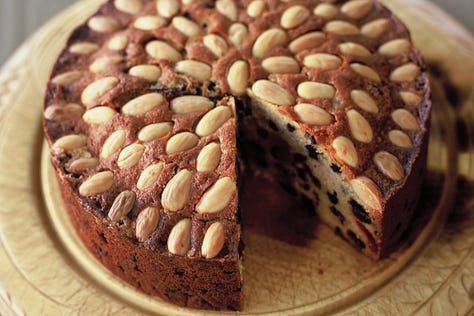


Chrismas cakes are also made in advance. They are usually kept upside down in an airtight container and ‘fed’ a small amount of brandy, sherry, or whisky every week until Christmas, when they are traditionally decorated with a covering of white marzipan and topped with holly. The Scottish Christmas cake, also known as the Whisky Dundee, is a popular variation to the Christmas cake. It is a light crumbly cake with currants, raisins, cherries and Scotch whiskey, decorated with blanched almonds.
King Cake

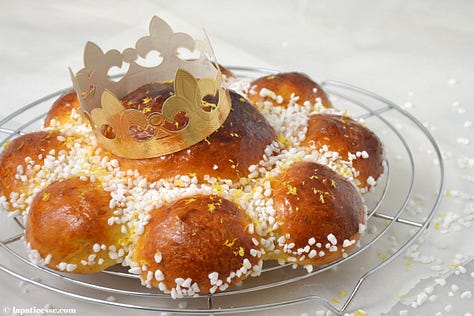
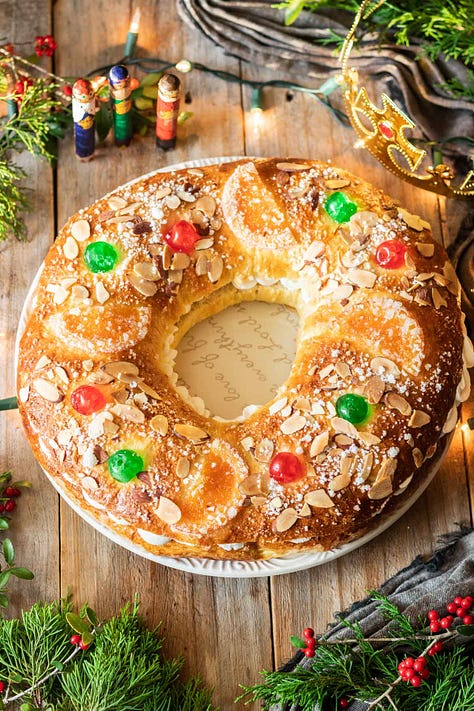
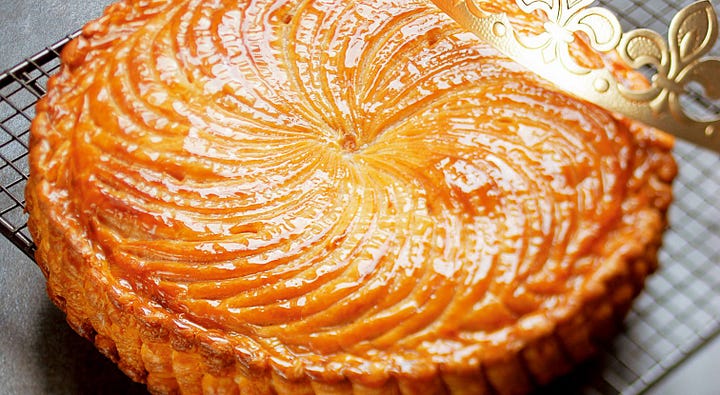
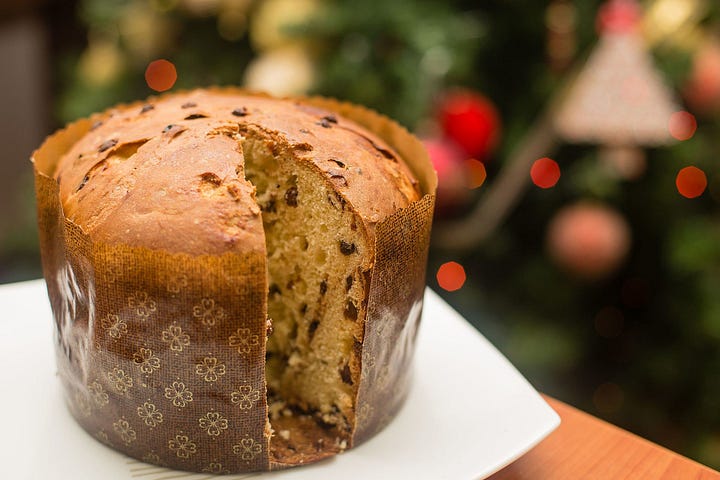
Another popular and more widespread sweet treat associated with Christmas is the King Cake. This traditional confection is particularly popular in Germany, France, Spain, and Portugal, and various regions influenced by these cultures. It was known in England as Twelfth Night Cake due to its connections with festivities surrounding the Christian celebration of Epiphany, also known as Three Kings' Day or Twelfth Night, which commemorates the visit of the Magi to the baby Jesus. However, in England, the Twelfth Night cake became less popular and was eventually displaced by the Christmas cake during the Victorian Era.
The King Cake is different to other Christmas cakes because the of the surprise hidden inside. Traditionally, a small trinket, figurine, or a dried bean known as a fève (French for bean) is baked into the cake, representing the baby Jesus. The three spices used in the recipe represent the Magi. Whoever discovers the trinket or bean in their slice is crowned the ‘king’ or ‘queen’ of the festivities and given a golden paper crown to wear. This person is then responsible for hosting the next gathering or providing the King Cake for the following year. Figurines of pop culture icons can be used instead of the fève in secular versions of the cake.
The King Cake is typically a ring-shaped cake made from rich, yeasted dough that is often flavored with hints of cinnamon or nutmeg. It is adorned with vibrant coloured sugar or icing in shades of green, gold, and purple, symbolizing faith, power, and justice, respectively, the gifts given to Jesus by the three Magi.
In southern France, the cake is called gâteau des rois (‘kings’ cake’). In Germany and Switzerland, the cakes are called Dreikönigskuchen (‘three kings cake’), shaped like wreaths and the fève is an almond. In Portugal, the cake is called Bolo-rei (‘king cake’) and in Spain, Latin America and Spanish-speaking areas of the United States the cake is called Roscón de Reyes (‘cake of kings’). In northern France, Quebec, Luxembourg and Belgium the cake is made of puff pastry, filled with frangipane and is called galette des rois, in Flemish Dutch it is called koningentaart (both translate to ‘kings’ tart’). In Italy and Italian-speaking regions around the world, the tradition of Christmas panettone (‘little loaf bread’), has roots dating back to the Roman Empire.
Gingerbread and Spice Cookies
The Origins of Gingerbread
Gingerbread has a fascinating history that stretches back to the ancient civilizations of Asia, where ginger was highly valued for its medicinal properties. Ginger and other spices spread to Europe from China, South East Asia, and India through the Middle East, with Muslim traders along well established trade routes such as the Silk Road. The first known recipe for gingerbread dates back to 2,400BC in Greece, where it was made by combining breadcrumbs and honey with ginger and other spices. These early gingerbread treats were often shaped into intricate designs, such as animals, flowers, and religious symbols.
Some sources attribute the origins of gingerbread in Europe to 992 AD, when an Armenian monk named Gregory of Nicopolis, shared his gingerbread-making knowledge with Christian bakers in France.
During the Crusades, Europeans returning from the Middle East also brought back spices like ginger, cinnamon, and cloves. Ginger became a favoured delicacy among the nobility and clergy, often presented as gifts and served at lavish feasts. Gingerbread was not only enjoyed for its delicious taste but also appreciated for its supposed medicinal properties, including aiding digestion and soothing various ailments.
The tradition of gingerbread making and its association with Christmas became widespread in Europe during the Middle Ages. In medieval Europe, gingerbread was not only considered a delicious treat but it was also formed into works of art. Elaborate gingerbread creations, including figures of animals, people, and even entire scenes, were crafted by skilled bakers and artisans. These intricately decorated gingerbread creations were often showcased at festive occasions, including Christmas markets and fairs, where the term fairings originated, referring to gingerbread that was sold to market goers from special gingerbread stalls. Gingerbread works of art also flourished during the Renaissance period in Europe.
And I had but one penny in the world, thou should'st have it to buy gingerbread. William Shakespeare, "Love's Labor's Lost"
Gingerbread Men
Queen Elizabeth I is credited with the creation of the first gingerbread men, which she had made to resemble the dignitaries that visited her court, and to whom she gifted the gingerbread men.


In 1875, the American childrens’ magazine, St. Nicholas published a fairy tale about The Gingerbread Man (also known as The Gingerbread Boy):
In the 1875 St. Nicholas tale, a childless old woman bakes a gingerbread man, who leaps from her oven and runs away. The woman and her husband give chase, but are unable to catch him. The gingerbread man then outruns several farm workers, farm men, and farm animals.
I've run away from a little old woman, A little old man, And I can run away from you, I can!
The tale ends with a fox catching and eating the gingerbread man who cries as he is devoured, "I'm quarter gone...I'm half gone...I'm three-quarters gone...I'm all gone!" Wikipedia
In different versions and retellings, the line about being eaten is sometimes excluded and in others, the Gingerbread Man famously taunts his pursuers with the line:
Run, run as fast as you can! You can't catch me. I'm the Gingerbread Man!
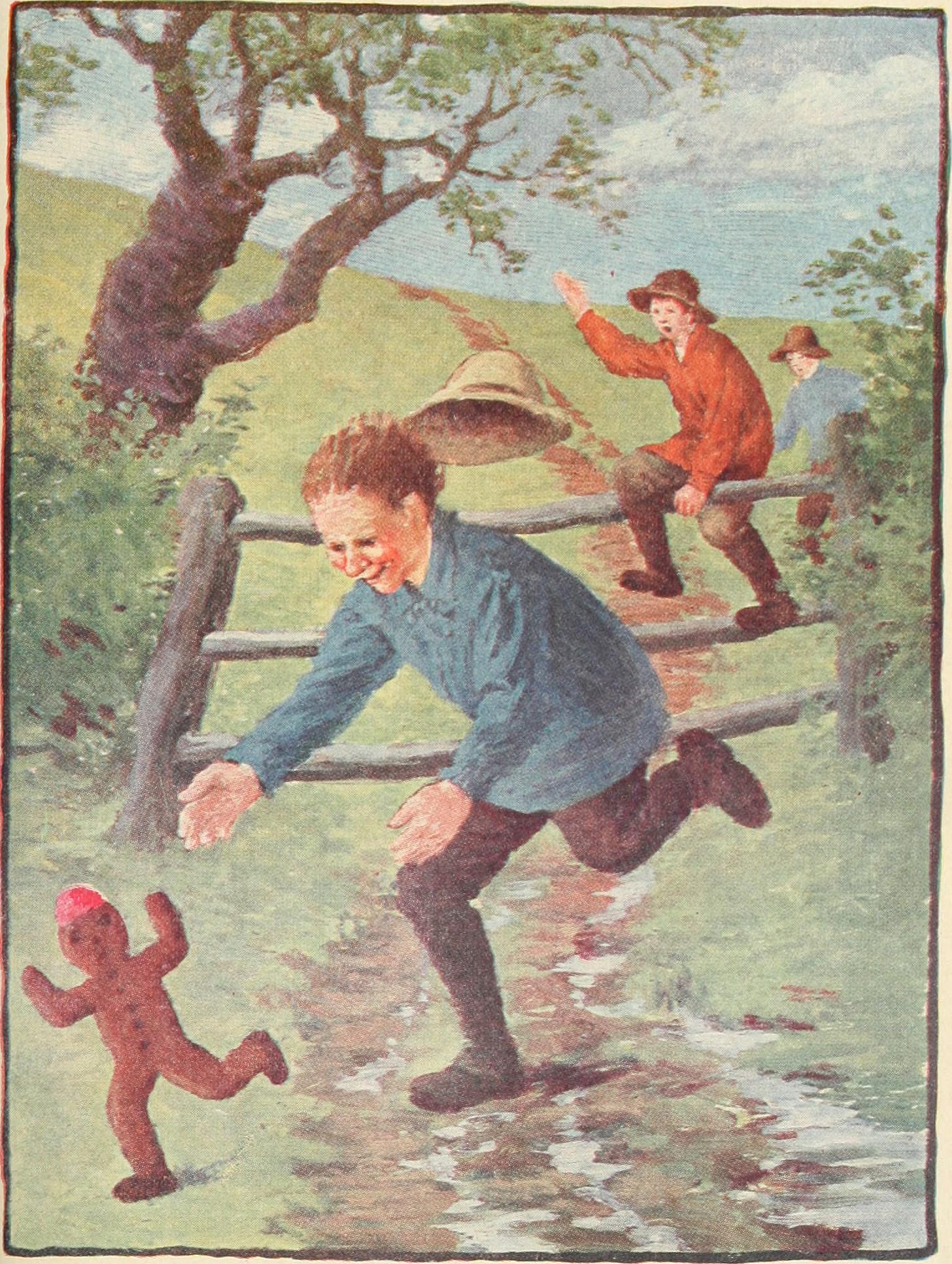
Regional Gingerbread Traditions
As gingerbread spread throughout Europe, different regions developed their own variations and traditions. In England, gingerbread initially referred to preserved ginger, which was often shaped in intricate molds and decorated with gold leaf. Over time, gingerbread evolved into a baked sweet treat, more akin to a biscuit or cookie that was often enjoyed during festive occasions and celebrations at Christmas time. These gingerbread biscuits styles are often stamped or pressed into intricately carved wooden molds, or shaped with cookie-cutters and decorated with piped icing.
In Germany, gingerbread, known as Lebkuchen, is a cherished Christmas tradition. The city of Nuremberg in Germany is particularly renowned for its delicious and intricately decorated Nuremberg Lebkuchen. These gingerbread treats were often made with a combination of spices, honey, nuts, and citrus peel, resulting in a distinctive flavor. Gingerbread cookies and Lebkuchen hearts, adorned with heartfelt messages, are popular as gifts and tokens of affection during the holiday season.

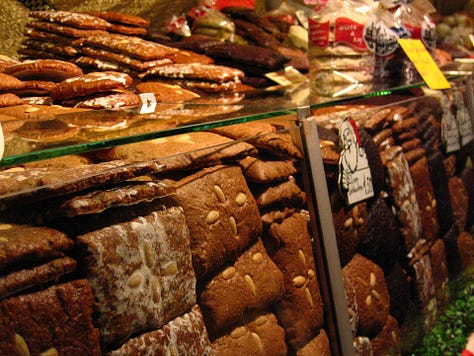
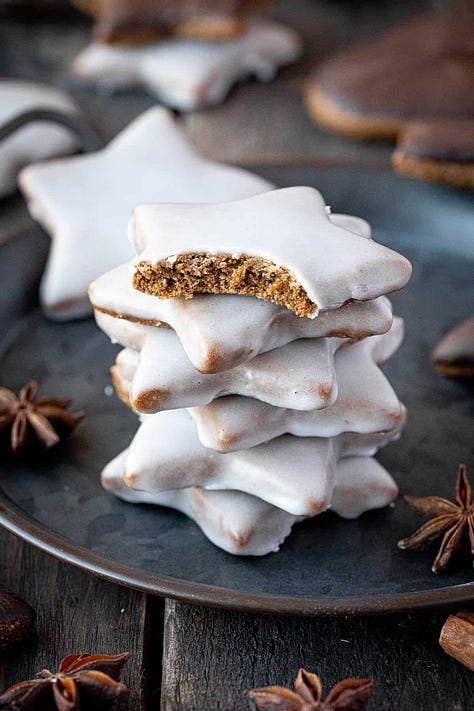
In France, there are many regional variations of the pain d'épices (spice bread) but the ones from Dijon in Burgundy are the most famous, although before the end of the 19th Century, Reims was first regarded as the ‘French capital of gingerbread.’ Interestingly, the regional French pain d'épices does not contain ginger and the pain d'épices of Dijon only contains aniseed and is made with jam and fruits. Spices were popular in the French Middle Ages but these spices declined in popularity and more recently, pain d'épices have become sweeter to cater for the changing French palette and tourists.
The Scandinavian countries of Norway, Denmark and Sweden, bake a popular thin, crisp spiced biscuit called pepparkakor (pepper biscuits) as they used to contain a lot of pepper. These days most mondern recipes omit the pepper but retain the other spices of cloves, cardammon, cinnamon and ginger. They are cut with cookie cutters, decorated with piped white icing, given as gifts, and are often strung and hung as Christmas decorations.
The Netherlands have their own version of spice biscuits called speculaas that are popular during the Christmas season, especially on December 5 or 6 to celebrate St. Nicholas’ Day, when well-behaved children are rewarded with speculaas biscuits in their shoes. Speculaas are made with a special mix of spices that includes ginger, cinnamon, cloves, mace, pepper, cardamom, coriander, anise seeds and nutmeg. Many of these spices weren’t commonly available until the 17th century when the Dutch East India Company opened up a direct trade route between the Netherlands and South East Asia. Speculaas are also called Dutch Windmill Cookies, as many of them are made using a traditional biscuit mold in the shape of a windmill.


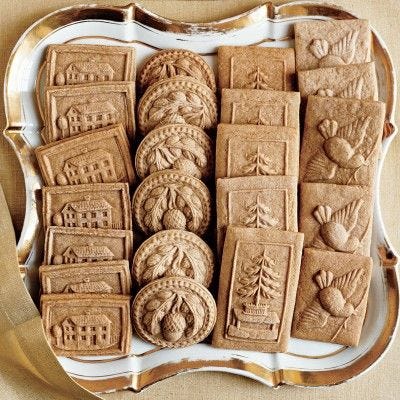
In Poland gingerbread cookies are called pierniczki, and the Polish city of Toruń has been famous for its pierniczki cookies since the Middle Ages. In the Czech Republic these cookies are called pernik, with the Czech cities of Pardubice and Prague famous for their gingerbreads. The Russians call their gingerbread cookies pryaniki, and the old Russian cities of Tula, Volgograd and Arkhangelsk are still famous for their gingerbread.


The Croatian licitar is slightly different. The gingerbread is made into symbolic shapes such as dolls, birds, horseshoes and wreaths, then dipped into a shiny red glaze and decorated with intricately piped royal icing.
Licitars adorn Croatian Christmas trees and are given away as a token of love to family members and lovers, who keep them forever and display them in their homes. The Spruce Eats
Gingerbread Cake
While gingerbread is often baked as a biscuit, it can also be baked as a dark and spicy cake like the Polish piernik or some versions of the French pain d'épices. I love using my Gramma Doris’ recipe for gingerbread. Gramma was a station cook on outback stations in North Queensland before joining as a cook for the Australian Army during WWII. I suspect that her recipe for gingerbread was learned or adapted and used from her time in the army, as the recipe replaces egg with bicarb soda to account for wartime egg shortages. The ingredients and portions are also easy to remember and the recipe is easy to make. Gramma’s recipe forms the basis of the traditional Yule Log Cake I bake for our annual Yule celebration at midwinter, which we will explore in the next section. I also use this recipe for my children’s kagemand birthday cakes, which I’ll write about in a future article.
Gingerbread Houses
The tradition of gingerbread houses began in medieval Europe as part of the decorative centerpieces created for festive occasions by royalty and the wealthy upper class. During the 16th Century, the fairy tale of Hansel and Gretel became popular in Germany and it was first published in Kinder- und Hausmärchen (Grimm’s Fairy Tales) by the Brothers Grimm in 1810. Although the story is not particularly ‘Christmassy,’ the concept of the witch’s gingerbread house, decorated with sweets was quickly translated into real gingerbread houses that became popular at Christmas.
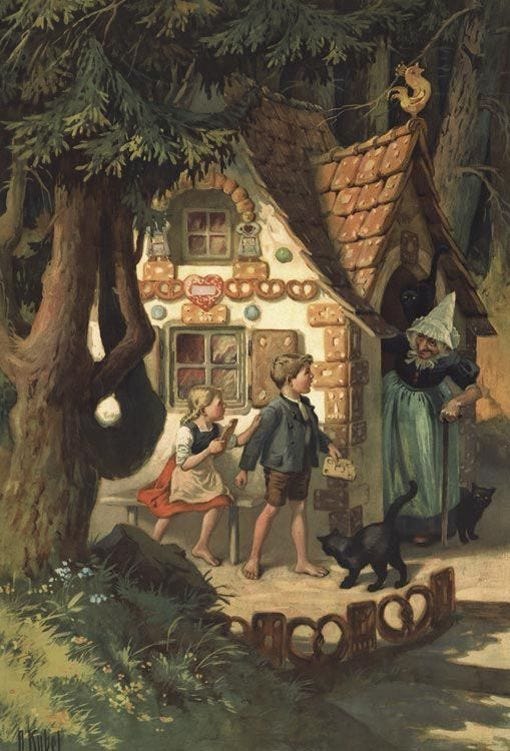
The tradition of maiking gingerbread houses soon spread to other European countries and eventually made their way to America through German immigrants. Today, gingerbread houses are a beloved part of Christmas celebrations in many cultures around the world. Families, friends, and communities gather to build and decorate gingerbread houses as a festive activity, often using royal icing, gumdrops, candies, and other confectionery delights. They continue to capture the enchantment and joy of the holiday season, offering a delightful combination of creativity, craftsmanship, and deliciousness for all to enjoy.

Yule Log Cake
The Yule Log Cake, also known as Bûche de Noël in French, is a traditional dessert with deep roots in European winter solstice and Christmas celebrations. The Yule Log Cake represents the ancient custom of burning a large log, known as the Yule log, as a symbolic ritual during the winter solstice. We’ll explore the Yule log tradition in a later article.
Over time, the Yule Log Cake emerged as a culinary adaptation of the Yule log tradition. It is a festive dessert shaped like a log, typically made of sponge cake or rolled cake filled with cream, ganache, or buttercream. The exterior of the cake is often covered with chocolate frosting, shaped into a bark-like texture, and it is decorated with marzipan or meringue mushrooms, powdered sugar to resemble snow, and other edible ornaments.

The Yule Log Cake is not only a delicious treat but also a centerpiece of holiday celebrations. It is typically served and enjoyed on Christmas Eve or Christmas Day. In some traditions, a small piece of the Yule Log Cake is saved until the following year to be thrown onto the Yule fire, bringing good luck.
Making the Yule Log Cake is one of my favourite annual traditions for our midwinter Yuletide party, celebrated on or around the 15th of July (southern hemisphere). As mentioned in the previous section, I use my Gramma Doris’ gingerbread recipe, baked in flat tins. Cream cheese sweetened with icing sugar is spread on top of the gingerbread, followed by strawberry or rasperry jam, and then the whole thing is rolled, wrapped tightly in cling wrap and placed in the fridge. While the log is chilling, I make marzipan mushrooms, using red food colouring for the toadstool caps and I whip up chocolate buttercream frosting.
The log is then taken out of the fridge, unwrapped, placed on its serving block and covered with the chocolate frosting to look as much like bark as possible, helped by crumbling a flake chocolate over the top. The marzipan mushrooms are placed on and around the log along with bits of greenery for decoration; ivy, pine branchlets, mint, wild fennel, even mallow, anything that is at hand and takes my fancy. The final flourish is placing my gorgeous gnome on top (you can see him in the photo below). He lives in a special box for most of the year and only comes out to carry out his Yule duties before being packed away again. Maybe I should get him a friend, or a wife so he doesn’t get lonely!
Oranges
Oranges have long been associated with Christmas. Dried orange slices and orange pomanders are frequently used as festive decorations, while fresh oranges can be found in warm spiced wine recipes and festive dishes.

Pomander balls have an interesting history. In medieval Europe, pomanders were cloth bags or perforated boxes of fragrant, dried herbs, used by herbalists to ward off illness, protect against malintent or to bring good fortune. Sometimes the strongly scented ambergris (dried secretion from the sperm whale’s bile duct) was added, and this led to the name for pomander derived from the French pomme d’ambre, meaning ‘apple of amber.’ These days, pomanders made of fresh oranges pierced by cloves and are still used for their fragrance and as decoration, if no longer as medicine.
Oranges are not native to Europe but were introduced to the region in a similar way to spices, through Muslim traders, though they remained wildly expensive and out of reach for most Europeans. Oranges and spices were popularised by the Crusaders in the 11th and 12th centuries during their travels to the Middle East and Mediterranean regions.
The Crusaders were captivated by the exotic flavours and scents of these fruits, and brought back samples and seeds with them upon their return to Europe. Oranges were initially cultivated in southern European countries such as Spain, Portugal, and Italy, where the Mediterranean climate was favourable for their growth. Harvest time for oranges in the Mediterranean coincided with Christmas and oranges became a prized and cherished fruit of the festive season, particularly amongst the wealthy, clergy and royalty who could afford them.
Over time, the cultivation of oranges expanded throughout Europe, with the introduction of new varieties, improved agricultural techniques and the development of orangeries. The concept of orangeries can be traced back to the Renaissance period in Italy, where wealthy patrons and aristocrats sought to cultivate exotic plants, including citrus fruits, as a symbol of status and luxury.
Orangeries were large and elaborate greenhouses, constructed as extensions of grand estates, palaces, and botanical gardens. They became popular amongst the wealthy upper class in Europe during the 17th and 18th centuries and were built primarily to provide a controlled environment for citrus trees during the winter months, allowing them to thrive and bear fruit even in colder climates. They were also used to grow other exotic, heat-loving plants and became a popular setting for elegant tea parties, afternoon receptions, and musical performances.

Today, with modern transportation and advancements in agriculture, oranges are available year-round in many parts of Europe. However, the association of oranges with Christmas traditions and the nostalgia for their historical significance continue to make them a popular symbol of the season, evoking a sense of warmth, tradition, and holiday cheer.
Chestnuts
Chestnuts have been cultivated and consumed as a staple from Europe to North America and Asia for thousands of years, especially in mountainous regions where grains are difficult to grow. In Europe, chestnuts were widely available and played an important role in the diet of rural communities. Roasting chestnuts over an open fire or buying roasted chestnuts from street vendors became a popular tradition, particularly in European countries during the autumn and winter seasons, when they were available.
Chestnuts were frequently included as a key ingredient in traditional Christmas recipes, such as stuffing for poultry, soups, and desserts. When the crusaders returned to Europe with sugar, countries like Italy, France, and Spain, began producing chestnut-based sweets and pastries, such as marrons glacés (candied chestnuts) and chestnut mont blanc, which became cherished Christmas delicacies.
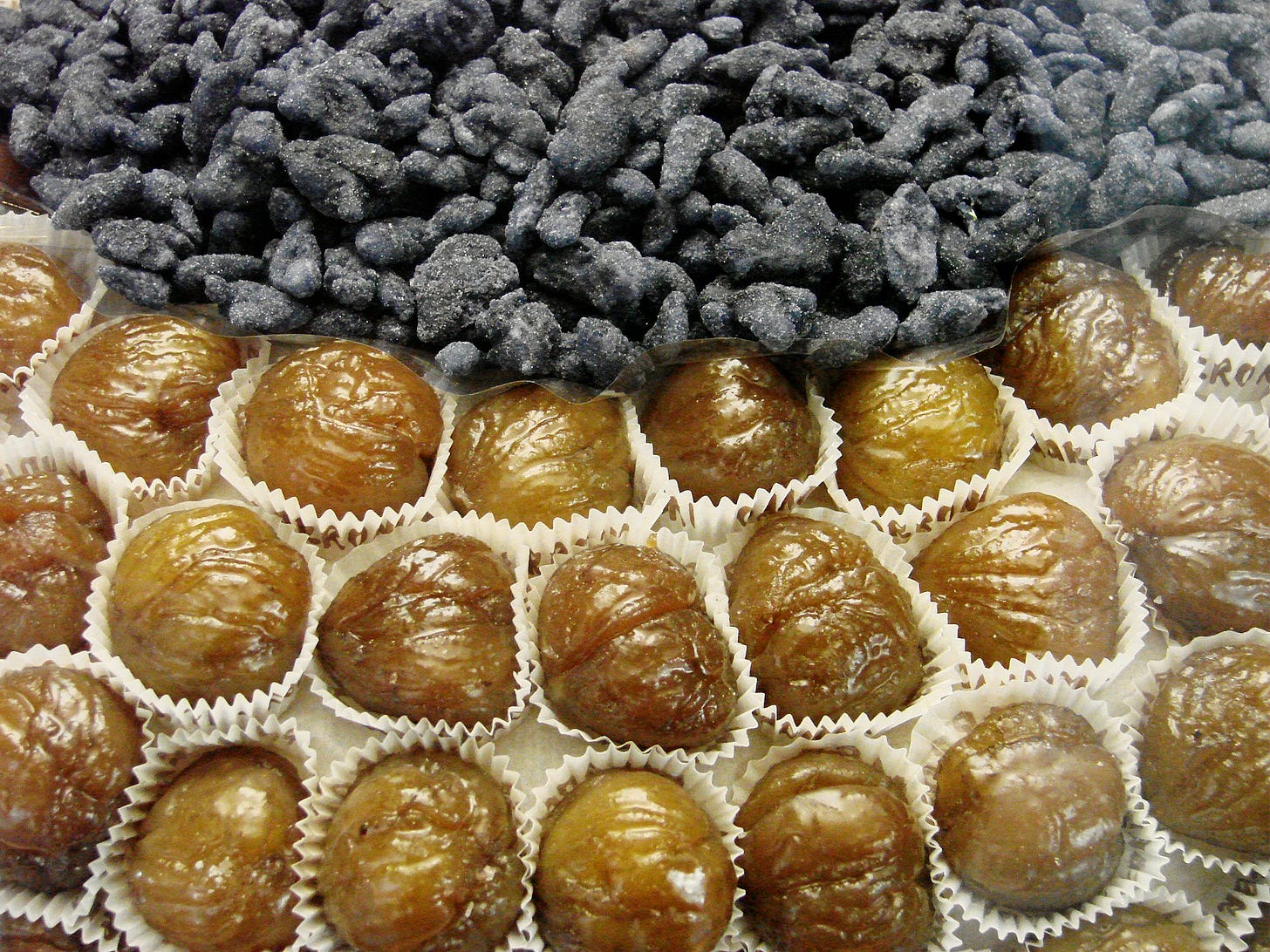
North America had its own species of chestnuts, which was also a staple food for the First Nations peoples across Eastern American. However, the American chestnut species was almost wiped out entirely in a matter of years by the chestnut blight, which was accidentally introduced into America at the end of the 1800s on imported Japanese chestnut trees. This 9 minute documentary provides an excellent summary of the history and status of the chestnut tree in America.
Porridge
The tradition of eating porridge during Christmas has deep historical roots and is observed in various cultures around the world. Porridge, a simple dish made by boiling grains or legumes in water or milk, has been a staple food for centuries. Western European countries most often eat porridge cooked with oats, while in Eastern Europe porridges made with a corn or wheat base are popular and in Northern Europe porridge with a rice base is most popular.
We have already learned about the English porridge called plum pottage or frumenty, which contained beef and mutton, suet, milled wheat or oats, and various fruits and spices. Frumenty evolved from the simpler, plainer porridge that early Christians traditionally ate on Christmas Eve after fasting throughout the month of Advent, in preparation for the twelve days of Christmas feasting.
In the Scandinavian countries of Sweden, Norway, and Denmark, a specific type of Christmas porridge called Risengrød or Risgrynsgrøt holds a special place in holiday celebrations. It is a rice porridge made by simmering rice in milk, sweetened with sugar and a touch of cinnamon and topped with a pat of butter. The tradition of eating risengrød during Christmas is believed to have originated from ancient fertility rituals where offering porridge to the spirits of the land was a way to ensure a good harvest in the coming year. Today, it is a popular dish served on Christmas Eve, often with a hidden almond in the porridge. The person who finds the almond is said to have good luck in the coming year. The Yule tradition of leaving out some pudding and butter for the Yule tomte/nisse will be explored in an upcoming article.
Porridge also has a significant place in the Christmas traditions of Finland, where a version called Joulupuuro is prepared. Joulupuuro is a rice porridge similar to risengrød and is typically served on Christmas morning. It is also customary to hide one whole almond in the pot, with the person finding it receiving a small gift or good luck.
In some Eastern European countries like Poland and Ukraine, a wheat-based porridge known as Kutia or Kutya is prepared for Christmas Eve, or on January 6, which is the date of Christmas according to the Russian Orthodox Church. Kutia is made with cooked wheat berries mixed with honey, dried fruits, nuts, and sometimes poppy seeds. It is served as a symbol of prosperity and good fortune for the coming year.
The tradition and symbolism of Christmas porridge varies from culture to culture, but in all of these cultures porridge is viewed as a comforting and communal dish to be enjoyed by families and friends as they gather to mark the holiday season.
Laufabrauð
Laufabrauð or leaf bread, sometimes also called snowflake bread, is a popular treat in Iceland during the Yule/Christmas season. It is a round, very thin flat bread, decorated with leaf or snowflake like geometric patterns and fried in hot fat or oil. The patterns are either cut by hand or with a heavy brass roller, called laufabrauðsjárn (leaf bread iron). The whole family is often involved in making laufabrauð and it was traditionally served on Christmas day with savoury dishes but can also be dusted with icing sugar and served as a sweet treat.
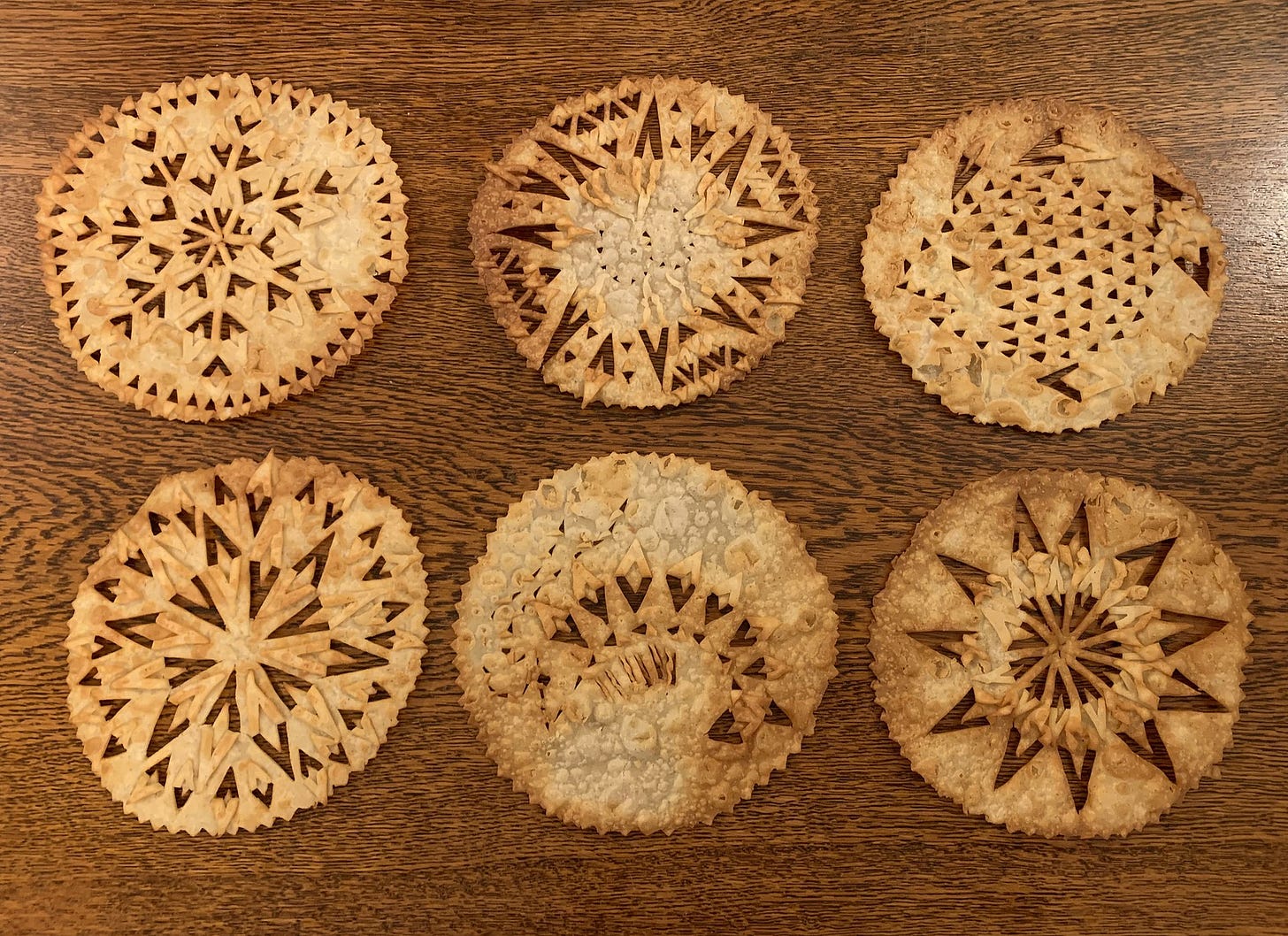
Festive Drinks
Glögg, Glühwein, and Mulled Wine
Glögg is a traditional Scandinavian warm spiced wine beverage typically enjoyed during the winter months, especially around the holiday season. It is similar to the English mulled wine or the German glühwein and is made by simmering red wine with a blend of spices like cinnamon, cloves, cardamom, and orange peel. Additional ingredients such as almonds, raisins, and sugar are often added to enhance the flavours. This warm and aromatic beverage is served hot and enjoyed in small cups or glasses. Try this recipe for Glögg. Recipes for glühwein and mulled wine can be easily found by searching online.
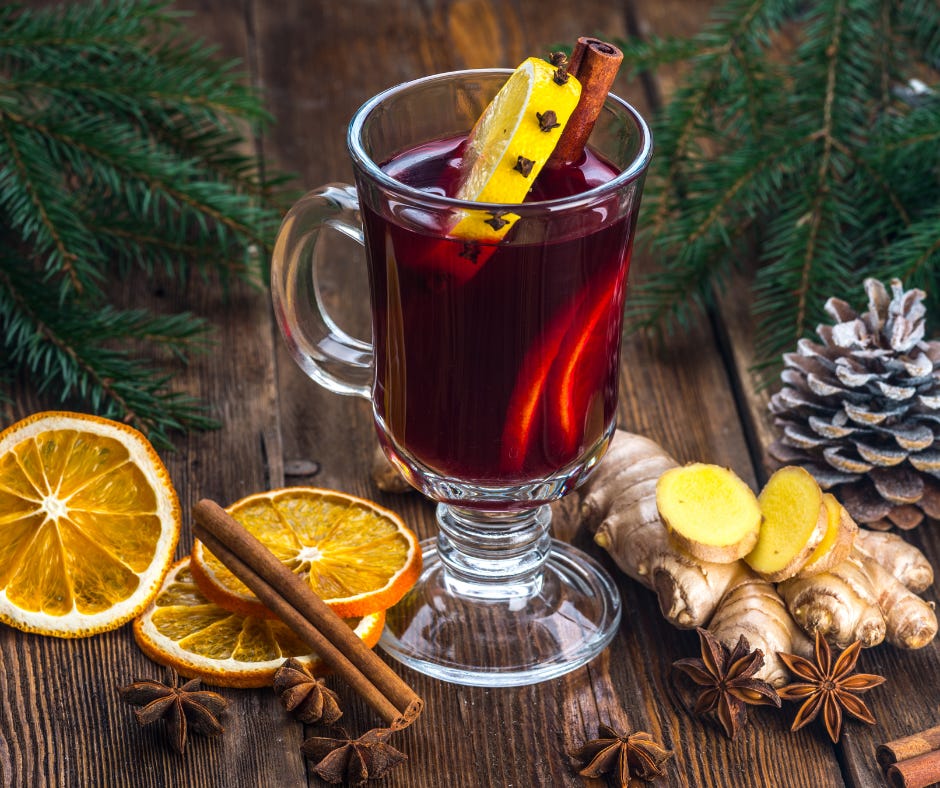
Eggnogg
Eggnog is a sweet dairy-based beverage consisting of milk, cream, sugar, egg yolks, and whipped egg whites, giving it a frothy texture. It can be made at home or purchased pre-made. Traditionally, eggnog includes a distilled spirit such as brandy, rum, whisky, or bourbon. It is enjoyed as a warm drink during the Christmas season in Canada, the United States, and some European countries, typically from late October until the end of the holiday season. In Venezuela and Trinidad, a chilled variation called ponche crema is consumed during the Christmas season.
In the 18th century, eggnog made its way from Britain to the British colonies, where it gained popularity in America. Inexpensive liquor, coupled with the availability of farm and dairy products, contributed to its widespread popularity. Eggnog became synonymous with holiday celebrations and is enjoyed on both sides of the Atlantic during the holiday season.

Hot Toddy
Hot toddy, also known as hot whiskey in Ireland, is a warm mixed drink typically made with liquor, water, honey, sugar or maple syrup, lemon, herbs (such as tea), and spices. It is traditionally consumed before bedtime, during wet or cold weather, or to alleviate cold and flu symptoms.
The term "toddy" originates in the 1610s from the taddy drink in British-controlled India, made with the fermented sap of palm trees. British colonist brought the recipe back to England, swapping out the palm sap with whiskey, and it became a popular drink during the wet and cold English winters. Some sources attribute the origin of the hot toddy to Irish doctor Robert Bentley Todd who prescribed hot drinks made of brandy, canella (white cinnamon), sugar syrup, and water to patients suffering cold and flu. In the mid-19th century, the hot toddy gained popularity as a remedy for the common cold. It was regarded as a cure-all, as mentioned in an article titled "How to Take Cold" in the Burlington Free Press in 1837:
“If your child begins to snuffle occasionally, to have red eyes, or a little deafness; if his skin feels dry and hot, and his breath is feverish — you have now an opportunity of doing your work much faster than ever before,” the unnamed writer states. The first step is to avoid calling a doctor. Next, feed the child excessive amounts. Finally, make him drink. “Ply him well with hot stimulating drinks, of which hot toddy is the best,” the writer recommends sagely. History of Hot Toddy from Vinepair.com.
The hot toddy originally included whiskey but as it made its way across the Atlantic to the American colonies, the preferred liquor changed to rum. Hot toddies are still a favourite drink for the winter season in the UK and the Americas, whether to treat a cold or to warm up on cold, wintry nights.

In the next article, we’ll delve into the traditions of wassailing, its links to carolling and the intriguing Welsh tradition of the Mari Lwyd. See you soon!


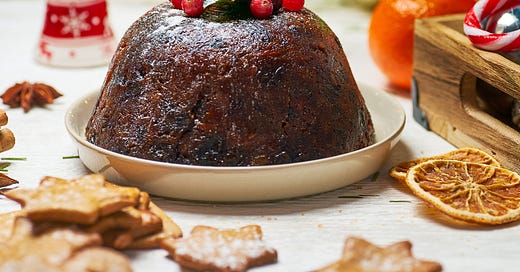



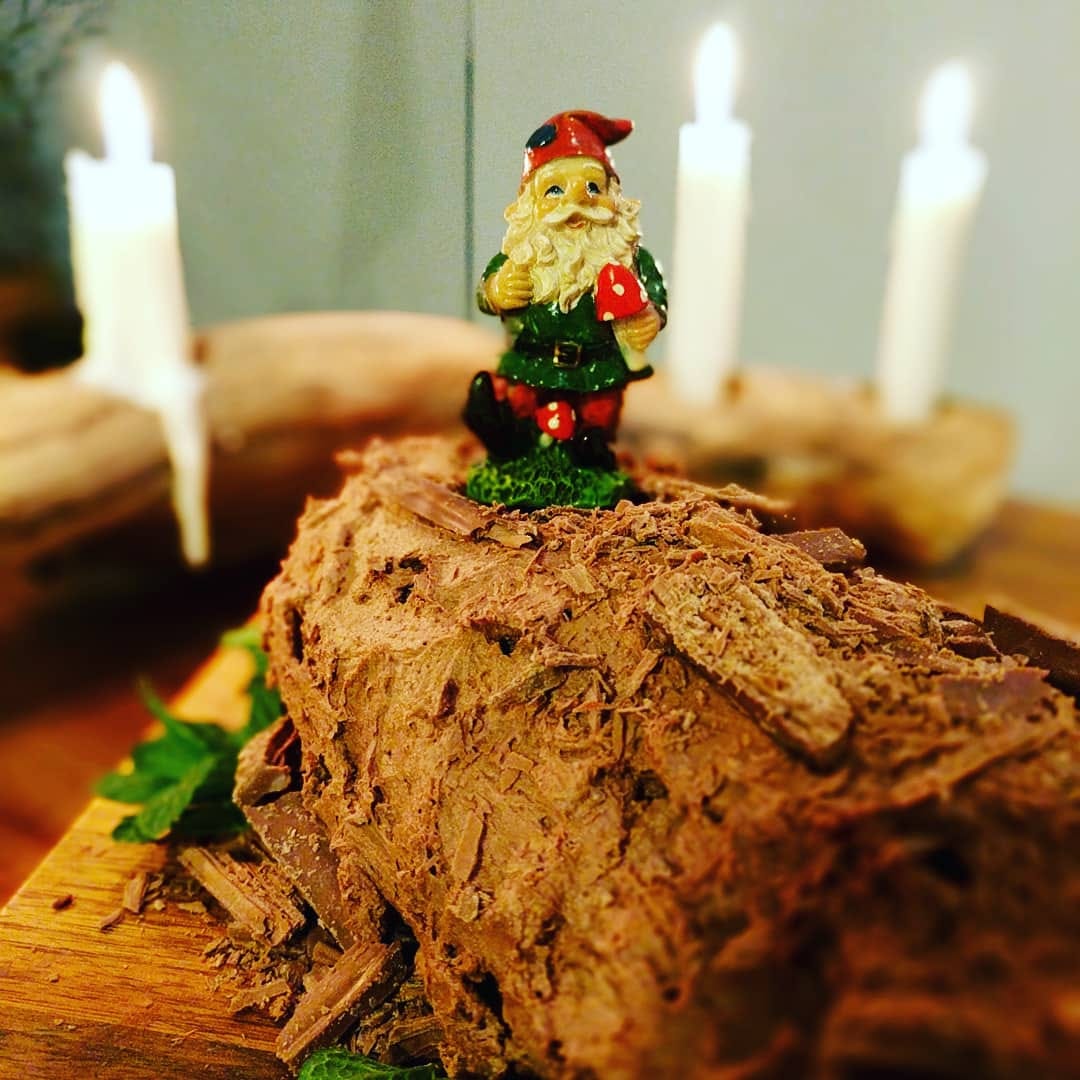
My goodness, this one took a long time but was so fun to research... there's so much to share!!! I've also shared a special gingerbread recipe from my Dear Gramma Doris. Now I will start on my belated Winter Solstice feast... Beef Wellington with green peppercorn sauce, herbed potatoes, and warm winter salad, topped off with a fig and ginger pudding and butterscotch sauce. Stay tuned for photos, whether I pull it off successfully or not 🤪.